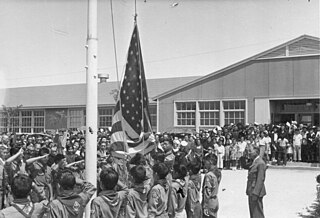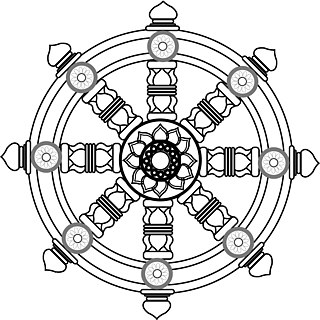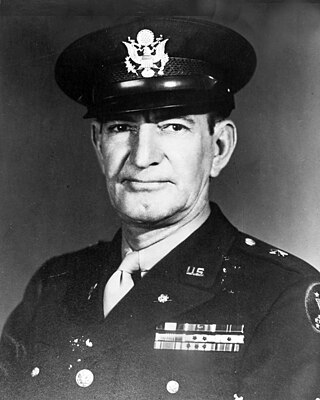Related Research Articles

During the early years of World War II, Japanese Americans were forcibly relocated from their homes in the West Coast because military leaders and public opinion combined to fan unproven fears of sabotage. As the war progressed, many of the young Nisei, Japanese immigrants' children who were born with American citizenship, volunteered or were drafted to serve in the United States military. Japanese Americans served in all the branches of the United States Armed Forces, including the United States Merchant Marine. An estimated 33,000 Japanese Americans served in the U.S. military during World War II, of which 20,000 joined the Army. Approximately 800 were killed in action.

Sadao Munemori was a United States Army soldier and posthumous recipient of the Medal of Honor, after he sacrificed his life to save those of his fellow soldiers at Seravezza, Italy during World War II.

The 442nd Infantry Regiment was an infantry regiment of the United States Army. The regiment is best known as the most decorated in U.S. military history and as a fighting unit composed almost entirely of second-generation American soldiers of Japanese ancestry (Nisei) who fought in World War II. Beginning in 1944, the regiment fought primarily in the European Theatre, in particular Italy, southern France, and Germany. The 442nd Regimental Combat Team (RCT) was organized on March 23, 1943, in response to the War Department's call for volunteers to form the segregated Japanese American army combat unit. More than 12,000 Nisei volunteers answered the call. Ultimately 2,686 from Hawaii and 1,500 from mainland U.S. internment camps assembled at Camp Shelby, Mississippi in April 1943 for a year of infantry training. Many of the soldiers from the continental U.S. had families in internment camps while they fought abroad. The unit's motto was "Go for Broke".

Go for Broke! is a 1951 black-and-white war film directed by Robert Pirosh, produced by Dore Schary and starring Van Johnson and six veterans of the 442nd Regimental Combat Team. The film co-stars Henry Nakamura, Warner Anderson, and Don Haggerty in its large cast.

The 100th Infantry Battalion is the only infantry unit in the United States Army Reserve. In World War II, the then-primarily Nisei battalion was composed largely of former members of the Hawaii Army National Guard. The 100th saw heavy combat during World War II, starting in September 1943 and continuing after being attached as a battalion of the Nisei 442nd Regimental Combat Team in June 1944. The unit was unofficially nicknamed the Purple Heart Battalion, with the motto "Remember Pearl Harbor".

The Go for Broke Monument in Little Tokyo, Los Angeles, California, commemorates Japanese Americans who served in the United States Army during World War II. It was created by Los Angeles architect Roger M. Yanagita whose winning design was selected over 138 other submissions from around the world.

Hiroshi H. Miyamura was a United States Army soldier and a recipient of the Medal of Honor, the United States military's highest award for valor, for his actions during the Korean War. He was one of the last two surviving Medal of Honor recipients of the Korean War, along with Ralph Puckett Jr. While he was held as a prisoner of war, the award was classified as top secret.

Colonel Virgil Rasmuss Miller was a United States Army officer who served as Regimental Commander of the 442d Regimental Combat Team (RCT), a unit which was composed of "Nisei", during World War II. He led the 442nd in its rescue of the Lost Texas Battalion of the 36th Infantry Division, in the forests of the Vosges Mountains in northeastern France.

The Military Intelligence Service was a World War II U.S. military unit consisting of two branches, the Japanese American unit and the German-Austrian unit based at Camp Ritchie, best known as the "Ritchie Boys". The unit described here was primarily composed of Nisei who were trained as linguists. Graduates of the MIS language school (MISLS) were attached to other military units to provide translation, interpretation, and interrogation services.

"The Lost Battalion" refers to the 1st Battalion, 141st Infantry, which was surrounded by German forces in the Vosges Mountains on 24 October 1944.

Roy Hiroshi Matsumoto was a Japanese-American soldier who fought with the Merrill's Marauders during World War II. He received several awards for his contribution including the Bronze Star Medal and the Legion of Merit.
Nisei is a Japanese-language term used in countries in North America and South America to specify the ethnically Japanese children born in the new country to Japanese-born immigrants. The Nisei are considered the second generation, and the grandchildren of the Japanese-born immigrants are called Sansei, or third generation.

Pierre Moulin was a French historian author, specializing in World War II, Nisei Japanese Americans, the Holocaust as well as Hawaiian history.
Asian Americans, who are Americans of Asian descent, have fought and served on behalf of the United States since the American Revolutionary War. During the American Civil War Asian Americans fought for both the Union and the Confederacy. Afterwards Asian Americans served primarily in the U.S. Navy until the Philippine–American War.
Susumu Ito was an American cell biologist and soldier born in Stockton, California. He was a Nisei, a second-generation Japanese American.

Buddhists make up a small percentage of the United States military, with a 2009 article stating that only 5,287 of 1.4 million military personnel identified themselves as Buddhists.

Brigadier General Kendall "Wooch" Jordan Fielder was an influential World War II officer in the United States Army, who served in Hawaii at the time United States' entry into World War II, and testified before Congress in favor of statehood.

The "Borinqueneers Congressional Gold Medal" is a Congressional Gold Medal awarded to Puerto Rico's 65th Infantry Regiment by President Barack Obama, at an official ceremony on June 10, 2014. On May 19, 2014, the United States House of Representatives passed the Bill, known as HR 1726 and three days later on May 22, 2014, the Senate approved Bill S. 1174. With the approval of both houses, the president signed the legislation which awarded the Congressional Gold Medal to the 65th Infantry, the first segregated Hispanic military unit, and the first unit of the Korean War, to receive such distinction.
The Nisei Soldiers of World War II Congressional Gold Medal is an award made for the Japanese American World War II veterans of the 100th Infantry Battalion, the 442nd Regimental Combat Team and the Military Intelligence Service. The Congressional Gold Medal is the most prestigious award given to civilians in the United States for achievements and contributions. The medal was approved by Congress under Public Law 111–254 in 2010 to honor the Japanese Americans who had served in the war. It was collectively presented on November 2, 2011.
James Takemori was an American judoka and World War II veteran.
References
- ↑ Congressional Record - House. 1963. p. 10664-10664.
- ↑ Congressional Record - House. 1963. p. 10664-10664.
- ↑ Harrington, Joseph D. (1979). Yankee Samurai: The Secret Role of Nisei in America's Pacific Victory. Detroit, Michigan: Pettigrew Enterprises, Inc. p. 252.
- ↑ Armstrong, Michael (November 12, 2011). "Homer WWII veteran honored with others". Deseret News. Retrieved 24 June 2021.
- ↑ Armstrong, Michael (November 13, 2011). "Homer WWII veteran receives medal". Anchorage Daily News. Retrieved 24 June 2021.
- ↑ Armstrong, Michael (November 12, 2011). "Homer WWII veteran honored with others". Deseret News. Retrieved 24 June 2021.
- ↑ Harrington, Joseph D. (1979). Yankee Samurai: The Secret Role of Nisei in America's Pacific Victory. Detroit, Michigan: Pettigrew Enterprises, Inc. p. 252.